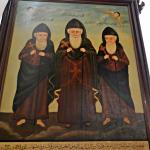Let me begin by sayingt that, if Fruit of the Loom put John Allen, Jr.’s face on Underoos, I’d be first in line for a pair — and where I live, nighttime temperatures get up into the nineties, so that’s really saying something. The man is the Man, the undisputed mack daddy, prince and heavyweight champeen of all Catholic journalists.
In National Catholic Reporter, he advises us to “keep an eye on” Cardinal Angelo Scola who is currently presiding as Patriarch of Venice.
First, he has enormous influence with Benedict XVI. Scola is a veteran member of the “Communio” school in Catholic theology co-founded by the current pope decades ago, and he shares Benedict’s passion for the late Swiss Catholic theologian Hans Urs von Balthasar. Scola also comes out of the Communion and Liberation movement, which is Benedict’s favorite among the “new movements” in the Catholic Church. To illustrate Scola’s pull, it’s enough to recall that it was Scola who suggested several months ago that Benedict consider creating a Vatican department dedicated to “New Evangelization,” which he promptly did.
The “new movements” Allen’s referring to are Focolare, Neocatechumenal Way and Communion and Liberation. Like them or not — and there are plenty of reasons do do either, as we’ll see — the role they’ve played in the new evangelization is impossible to overstate.
To sketch them in brief, Neocatechumenal Way was founded in 1964, in Spain, by Carmen Hernansez and Kiko Arguello, a guitar player. NC Way operates from the premise that catechesis and conversion should involve an intense, lifelong committment. According to its statutes:
The Neocatechumenal Way is at the service of the bishops and parish priests as an itinerary for the rediscovery of Baptism and an ongoing education in the faith, offered to the faithful who want to revive in their lives the riches of Christian initiation by travelling this path of conversion and catechesis.
Toward this end, NC Way organizes members into communities ranging in number from 20 to 50. Each community moves through eight stages of “instroduction” — a process, according to Manchester Guardian’s Madeline Bunting, that can take over 20 years.
Bunting estimates its overall membership at “somewhere between 500,000 and a million.” It operates Redemptoris Mater seminaries all over the world, and has been noted for its impressive turnouts on World Youth Day.
Communion and Liberation is the brainchild of Msgr. Luigi Giussani, who founded the group in 1954, originally under the name of Gioventu Studentesca, or “student youth.” Its purpose, a CL friend tells me, was to present future members of Italy’s intelligentsia with a compelling alternative to Marxism and neo-fascism. “The communists and the fascists fought each other,” says my friend, who joined in the 1970s, as a university student. “And they both fought us.”
CL sends its members through Schools of Community, or SOCs, where they study Giussani’s works, including The Religious Sense, At The Origin Of The Christian Claim, Why The Church?, and Is It Possible To Live This Way? The intended takeaway, acording to Wiki:
CL describes its purpose as “the education to Christian maturity of its adherents and collaboration in the mission of the Church in all the spheres of contemporary life.” It aims to communicate the awareness that Christ is the one true response to the deepest needs of people in every moment of history. CL says that it requires only that Christ be recognized as immediately present. The person who encounters and welcomes the presence of Christ undergoes a conversion that affects not only the individual but also the surrounding environment.
Unlike the other groups, CL does not maintain very precise records on its membership, though Wiki reports that over 100,000 people attend SOC meetings in Italy alone.
Focolare — which, to me, has always sounded like the title of a Jerry Vale song — was founded in 1943 by an elementary-school teacher named Silvia Lubich, who later changed her name to “Chiara” after Clare of Assisi. (It may also have occurred to her that “Silvia Lubich” sounded a little too, you know, Five Towns for the leader of a Catholic ecclesial movement.) Its rather ambitious charism is to promote unity — within the Church, among the various Christian denominations, between different faiths, and ultimately, throughout the world. Currently, Focolare claims “140,000 core members and some two million affiliates in 182 nations:”
Focolare is unique among the three not only in that its founder and longtime president was a woman, but because Lubich decreed that only women should succeed her to the presidency. It may, in fact, be largest fully fuctional co-ed matriarchy in the entire Catholic Church. As Maria Voce, Lubich’s successor, explains to Maestro Allen:
The logic comes from the inspiration of Chiara. Remember that she gave Focolare the name ‘The Work of Mary.’ It’s the work of Mary not in the sense of a devotion to Mary, but in the sense of bringing Jesus to the world, and Chiara wanted the Focolare to have the same objective – to carry, through the experience of reciprocal love, the living presence of Jesus. It’s an essentially Marian work. As such, Chiara felt the president should be a woman, even if she didn’t always feel that so clearly. It was an idea that grew within her, based on the Marian function of the work. It was John Paul II who confirmed it
All three of these groups have been attacked for secrecy, brainwashnig, and venerating their leaders to an unhealthy, not to mention un-Christian, degree. In 1995, Gordon Urquhart, a former member of Focolare, published The Pope’s Armada, imputing to the movements:
Many of their main characteristics reflect those of Mao’s Red Guards—the fanaticism, the blind obedience, the sloganeering, the personality cult around the Pope, manipulation of the media, anti-intellectualism, denunciations, the formulation of rigid ideology, a younger generation mobilized in the struggle against their elders . . .
Madeline Bunting reports that Msgr. Joseph Buckley, vicar-general of the diocese of Clifton, England:
likened the methods of the NC to the totalitarianism of fascism and communism. He claimed that it used brainwashing techniques of repetitive music and phrases and made demands on members, in time and commitment, that threatened family life. He said it attracted the mentally weak and emotionally unstable with ‘tragic consequences’, while the commitment of adherents is ‘properly named fanaticism’.
All of this is a little too hyperbolic to take seriously. I’ve lived in China, and spoken with people who survived the Cultural Revolution — Focolare to Red Guards is no comparison to make lightly. But at the least — the very least — it seems fair to say that these groups, at least some of the time, adopt a high-intensity style and demand an unusual amount of committment from their members. What I find remarkable is not that intelligent critics are deeply disturbed by their style, and find their demands excessive beyond reason, but that hundreds of thousands of people find them agreeable. They can’t all be lemmings.
The reason should be pretty obvious. The old concept of Catholic community, centered on the parish, worked fine in pre-industrial times, where people lived cheek-by-jowl in cozy little villages (if they were lucky, cozy little villages with terra-cotta roofs). It survived in America until World War Two, where European immigrants, their children, and sometimes their children’s children, lived as “urban villagers,” in enclaves just as tightly knit as that nameless hamlet near Foggia that Pop and Nona left behind them.
Now? Thanks to the freeway and the suburb, we’re all islands unto ourselves. The Internet is the bottle in which we leave our notes. The parish church is just a building. Anyone who wants community has to seek consciously to build one. And, as often happens when we try deliberately to re-create something that once occurred naturally, we overdo it; the actual result ends up looking like a distortion of the intended result. Think of bottle blondes and you’ll get the basic idea.
If groups like this really are the future of the Church, I’m in bad shape. De gustibus non disputandum est, but I’ve never been a joiner. The idea of staking so much of my time, my spirituality, and when you get down to it, my very sanity on, well, other people, scares me senseless. That’s not to say I’m a misanthrope; I like people just fine, as long as I have a say in the terms on which we relate. That’s why I’ve gotten some of my most satisfying experiences of Christian fellowship over the Internet, where associations are at their most voluntary. As I wrote in “I Got My Religion Online”:
Life on the board both primed me for life in the Church and spoiled me for it. Whenever a parish busybody inquires about my life in a way that feels invasive, I wish I could ignore him as easily as I can an uninvited PM. Once on retreat, when I saw two women nearly come to blows over pride of place in the kitchen, I felt like saying, “Cool off. Take a vacation. Go post in another thread for a while.”
In the interest of full disclosure, I should state that I spent a few months going to CL School of Community meetings. I found nothing coercive or cultlike about them. For example, to this day, I wouldn’t know Msgr. Giussani if he sneaked up behind me in church and kicked me in the apse; his picture was not hanging, Castro-style, on the walls of the places where we held our meetings. When I left — mainly because I’ve had more fun in dentists’ chairs than I had reading Giussani’s Is It Possible to Live This Way?* — nobody went to any unseemly lengths to coax me back.
I know what you’re thinking. Ha, ha. Very funny. But you know, coming off like a headstrong jerk has its advantages. If CL has some equivalent of the Regnum Christi come-on, “In the beginning, God saw you as a member of this group,” only a fool would have pulled it on me without a starvation bunker and Jane Fonda handy.
*It didn’t especially help that by far the best eye candy in our cell, or whatever they’re called, was a Memora Domine. That’s right, she was from Italy, and in looks a cross between Keira Knightley and Irene Pappas. And she was a consecrated celibate. As St. Sebastian once said, somebody shoot me.











